Trams of Hungary and much more...
On this page I'll try to recall my first memories of different tram types. I don't want to enumerate every single type, nor to deeply explain any of them historically or technically. I will also not mention the 2-axle streetcars that were sooooo common back then, because I will write more about them later. That doesn't mean that I don't like them. I like them. I like them so much that I will dedicate separate pages to them. But not now :-)
Bengali (Bengáli, Benga, "home-made articulated")
 This
4-axle articulated was a mistery to me: I only saw them very rarely at
Újpest, and I never rode them: they were used on routes were I never had
anything to do (I was a little child so I wasn't allowed to just go out
and take a ride). And then by 1983 they dissappeared from Budapest! The
fact that this tram (designed in 1960-61) disappeared one year before
the last 2-axles (manufactured between 1896 and 1912) gives you an idea
of what a bad design it was! When I saw them I had a feeling that this
was not a hungarian tram: its look was totally different, it didn't fit
into the category "Budapest tram". I even though that it was made elsewhere.
And I was right when I felt that this was tram was odd in some ways: normally
the cars of the Budapest tram network were produced by companies specialized
for building railway vehicles - like Ganz or Schlick&Nicholson, but
not this tram! The Bengali was designed and built at the main maintenance
workshop ("Füzesi Árpád Főműhely") of the FVV, the Budapest tram company.
The project started out as the reconstruction of old Ganz mid-entrance
twins (designed around 1929-30) into articulated trams, but these were
in such a bad shape that they produced new frames instead of using the
old ones. The construction is rather primitive: the Bengali consists of
two 2-axle cars connected by a middle part using two joints. No bogies,
etc... Of course they weren't working out quite the way they were expected
in Budapest, so some of the cars were sold to Debrecen,
Miskolc and Szeged, where they are still
being used, which is kind of sad because they're really uncomfortable
and they're constantly damaging the tracks - but back in then these cities
had no budget to buy modern trams. Some Bengalis were of course kept by
Budapest (series 1100 and 1200), but when the CKD Tatra T5C5 was introduced,
they were anulated and scrapped - after only 20 years in service!
Most Bengalis used in Debrecen, Miskolc and Szeged today were not bought
from Budapest but manufactured at Debrecen until 1978.
This
4-axle articulated was a mistery to me: I only saw them very rarely at
Újpest, and I never rode them: they were used on routes were I never had
anything to do (I was a little child so I wasn't allowed to just go out
and take a ride). And then by 1983 they dissappeared from Budapest! The
fact that this tram (designed in 1960-61) disappeared one year before
the last 2-axles (manufactured between 1896 and 1912) gives you an idea
of what a bad design it was! When I saw them I had a feeling that this
was not a hungarian tram: its look was totally different, it didn't fit
into the category "Budapest tram". I even though that it was made elsewhere.
And I was right when I felt that this was tram was odd in some ways: normally
the cars of the Budapest tram network were produced by companies specialized
for building railway vehicles - like Ganz or Schlick&Nicholson, but
not this tram! The Bengali was designed and built at the main maintenance
workshop ("Füzesi Árpád Főműhely") of the FVV, the Budapest tram company.
The project started out as the reconstruction of old Ganz mid-entrance
twins (designed around 1929-30) into articulated trams, but these were
in such a bad shape that they produced new frames instead of using the
old ones. The construction is rather primitive: the Bengali consists of
two 2-axle cars connected by a middle part using two joints. No bogies,
etc... Of course they weren't working out quite the way they were expected
in Budapest, so some of the cars were sold to Debrecen,
Miskolc and Szeged, where they are still
being used, which is kind of sad because they're really uncomfortable
and they're constantly damaging the tracks - but back in then these cities
had no budget to buy modern trams. Some Bengalis were of course kept by
Budapest (series 1100 and 1200), but when the CKD Tatra T5C5 was introduced,
they were anulated and scrapped - after only 20 years in service!
Most Bengalis used in Debrecen, Miskolc and Szeged today were not bought
from Budapest but manufactured at Debrecen until 1978.
UV (3200, 3300, 3400 and 3800-series)
 UV
streetcars are a part of Budapest and of course a part of me, too: my
grandma used to live at Bartók Béla út, where routes 9, 19, 47 and 49
were all operated with UV's. But they were also there at various other
places in the city: with a total number of 375 this was the biggest series
of one type ever in the life of the Budapest tram. And this 375 pcs do
not include the 2-axle trailers that is coupled between the motorcars
on heavy-traffic routes! In those years and even now the UV is _the_ hungarian
tram type. The interesting thing about them is perhaps that they were
somewhat like the older cars but they were faster and more agile.
UV
streetcars are a part of Budapest and of course a part of me, too: my
grandma used to live at Bartók Béla út, where routes 9, 19, 47 and 49
were all operated with UV's. But they were also there at various other
places in the city: with a total number of 375 this was the biggest series
of one type ever in the life of the Budapest tram. And this 375 pcs do
not include the 2-axle trailers that is coupled between the motorcars
on heavy-traffic routes! In those years and even now the UV is _the_ hungarian
tram type. The interesting thing about them is perhaps that they were
somewhat like the older cars but they were faster and more agile.
Back then I did not know much about trams, so I didn't recognize that there were different models. For example all UV's in our district were the ones with a narrow middle door, and I didn't see the ones with the double-width middle entrance. On the other hand I knew that this tram was also made by Ganz, so they became my favorite company :-) In these days I know much more about them, you can see this on another page: UV forever!
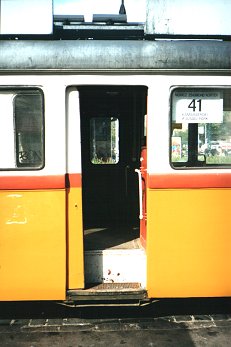

Above: the narrow and the wide middle door
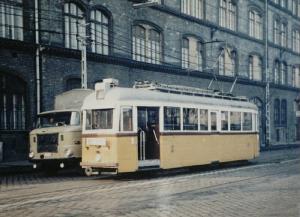 My
parents used to call UV's "Stuka" which was wrong, because
this was the nickname for the predecessor of the UV: the 3600-series.
As you can see on the picture to the left, this car looks almost like
a single UV streetcar, but was in fact an earlier construction by Ganz,
designed just before WW2. In that time most hungarian trams were 2-axles
and had a very high floor and open perrons with narrow doors on both end,
which hindered the flow of passengers in and out. Contrary to that, the
3600 was a "quite-low-floor" 4-axle (2 bogies), had a fully closed body
(with temperating heating - also new to the Budapest tram passengers)
with two wide and one narrow middle door on each side. And it was fast!
The name "Stuka" refers to the growling-screaming sound emmitted by these
streetcars: Stukas were german-made dive-bombers (Sturzkampf-flugzeug
- the Junkers Ju-87 was the most prominent type) that produced a sirene-like
sound while attacking.
My
parents used to call UV's "Stuka" which was wrong, because
this was the nickname for the predecessor of the UV: the 3600-series.
As you can see on the picture to the left, this car looks almost like
a single UV streetcar, but was in fact an earlier construction by Ganz,
designed just before WW2. In that time most hungarian trams were 2-axles
and had a very high floor and open perrons with narrow doors on both end,
which hindered the flow of passengers in and out. Contrary to that, the
3600 was a "quite-low-floor" 4-axle (2 bogies), had a fully closed body
(with temperating heating - also new to the Budapest tram passengers)
with two wide and one narrow middle door on each side. And it was fast!
The name "Stuka" refers to the growling-screaming sound emmitted by these
streetcars: Stukas were german-made dive-bombers (Sturzkampf-flugzeug
- the Junkers Ju-87 was the most prominent type) that produced a sirene-like
sound while attacking.
Originally the car had a 2+1 seat arrangement (2 seats on one side, 1 on the other), but later this was turned into 1+1. Also, the carpeted seats were replaced with wooden ones, the heating was removed and the middle door was closed permanently. Even worse, the control switch was altered so that the last few shaunting stages were removed - this made the car much slower. This can be explained with the lack of proper maintenance and the low budget of the tram company: they spent their money on the UV's and other things. What a shame: although the bogie of the Stuka had serious flaws, this streetcar deserved better! They were scrapped by early 1981, only two cars were reserved, they're waiting to be renovated.
I personaly don't remember Stukas very well: I just know that when I first rode with a UV I noticed that something was wrong: the tramcar seemed familiar but it had a one-step stair at both ends before the perron and doors! I was clueless. Later of course I found out that most Stukas didn't had this step but a small ramp, which was much more comfortable for a small child than that stair!
UV trailers (5800, 5900, 6000-series)
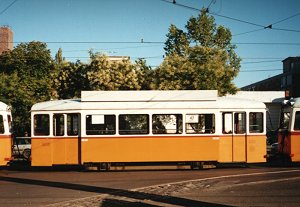
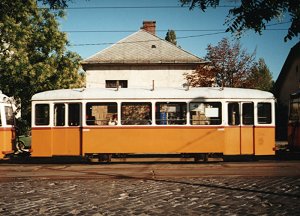
Two trailers with slight differences: notice the height
of the side windows!
The title is not proper, since these trailers were made long before the UV was introduced. And they're not even the same model: the 2-axle trailers were produced in several series (R5, EP, FP) between 1939 and 1954 to be used with different motorcars in Budapest. The early ones were quite comfortable: they had carpeted seats (now they have wooden ones), hidden lights and special interior covering. They also had open perrons with double-size doorways. In the next series, the interior decoration and the carpeted seats were removed but the open end perrons stayed. Later they were produced with closed perrons with telescopic doors.
They are used between two UV motorcars since 1957 and that is a proven setup! Over the years this three-piece set (UV+trailer+UV) became so integrated that the trailers are now considered as the part of the same vehicle series - some of the passengers don't even know that they're lacking motors, because of the harsh noise of the undercarriage.
The main thing I liked about them when I was a child was the wooden seat. UV motorcars in the train sets had carpeted (leatherette) seats which were more comfortable, but the stripy wooden seats of the trailers were fun for a kid :-)
Ganz CSMG2 articulated ("ICS", 1300, 1400-series)
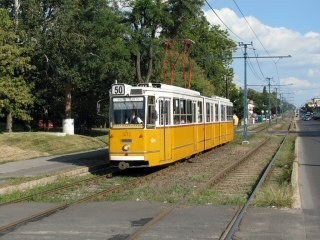 I
remember seeing the Ganz articulated first when I went to kindergarten.
Route 61 - which was operated with these trams - was not far so I once
or twice caught a glimpse of them - but I didn't had a chance to ride
them. In 1978 UV's on routes 4 and 6 (Grand Boulevard)
were replaced with CSMG2's and that's where I first used them. They were
very much like the UV's but they were more modern in a not so pleasant
way. They had a higher floor with narrow stairs. On the other hand they
were long and I liked that :-) Route 2 was a special place for these trams:
this line runs along the river Danube, where they were really fast, much
faster than on the Grand Boulevard where routes 4 and 6 run. Unfortunately
the tracks ran on top of a long bridge-like construction built long ago
which was in a bad shape so they put up a speed limit. From that point
on Route 2 was not so special anymore... (Remark: Route 2 still runs at
the same place but the bridge-like thing was renovated since. Unfortunately
the trams are not allowed to run fast enough anymore - this is because
of the tachograph they are equipped with now. Originally they did not
have this gadget so they could run as fast as they wanted.)
I
remember seeing the Ganz articulated first when I went to kindergarten.
Route 61 - which was operated with these trams - was not far so I once
or twice caught a glimpse of them - but I didn't had a chance to ride
them. In 1978 UV's on routes 4 and 6 (Grand Boulevard)
were replaced with CSMG2's and that's where I first used them. They were
very much like the UV's but they were more modern in a not so pleasant
way. They had a higher floor with narrow stairs. On the other hand they
were long and I liked that :-) Route 2 was a special place for these trams:
this line runs along the river Danube, where they were really fast, much
faster than on the Grand Boulevard where routes 4 and 6 run. Unfortunately
the tracks ran on top of a long bridge-like construction built long ago
which was in a bad shape so they put up a speed limit. From that point
on Route 2 was not so special anymore... (Remark: Route 2 still runs at
the same place but the bridge-like thing was renovated since. Unfortunately
the trams are not allowed to run fast enough anymore - this is because
of the tachograph they are equipped with now. Originally they did not
have this gadget so they could run as fast as they wanted.)
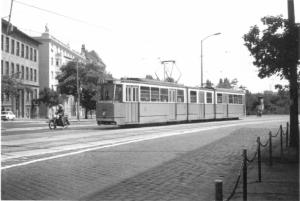 You
might have noticed the word "ICS" by the names above. "ICs" is short for
"Ipari Csuklós" which means "industrial articulated". What can be industrial
about a tram car? Well, this refers to the "home-made
articulated", the Bengali: that tram was built by the tram compay,
so it was home made, while this was built by a company specialized for
this, so it was "industrial". Not a very bright idea for a name, but the
abbreviation "ICS" sounds nice in hungarian ("eey-chay")...
You
might have noticed the word "ICS" by the names above. "ICs" is short for
"Ipari Csuklós" which means "industrial articulated". What can be industrial
about a tram car? Well, this refers to the "home-made
articulated", the Bengali: that tram was built by the tram compay,
so it was home made, while this was built by a company specialized for
this, so it was "industrial". Not a very bright idea for a name, but the
abbreviation "ICS" sounds nice in hungarian ("eey-chay")...
As it turns out, ICS's are not the best trams ever built by Ganz (at the time the company was called Ganz-MÁVAG): it was a nice try for designing an articulated with Jacob-bogies (I don't know what you call it), but it had its flaws. In the time of its design (1964) Ganz had problems, and they didn't had the time to experiment. There were two series of ICS's with minor differences. The last batch came out late (1978), later than forseen in the contracts: it's said that Ganz was overloaded with "big railway" jobs so the tram had very low priority. And that reflects in the fact that this was the last time BKV ordered new trams from this company: the next vehicles came from the czech company CKD Tatra. As for the afterlife: Ganz went bankrupt in the late eighties, so it was split in parts. Some of these were later bought by foreign firms (Ganz-ANSALDO - the part of Ganz that made the electrical components), some of them tried new and new joint ventures (Ganz-Hunslet - the part that built railway vehicles, now they are a different company with a different name I don't remember at the moment). In the nineties BKV contracted one of these "post-Ganz" companies to rebuild 40 pieces of CSMG2 trams. These have then became KCSV7's: the frame is almost completly new (the chassis and the motors remained), the old control system was replaced with a GTO thirystor system and the interior design has also changed. Apart from the fact that the floor height remained, these KCSV's are quite good, you can see them on Route 2.
CKD Tatra T5C5 ("Tátra", 4000, 4100, 4200, 4300-series)
 I
already told you about kindergarten where I used to
watch trams on Route 61 in the late seventies. I saw these Tatras there
too: one of the first lines where BKV introduced this new type was Route
61. That was some sensation for us, kids! We used to keep an eye out for
the trams, and we were lucky if we saw a Tatra, and not a Ganz
articulated that was common there. A new tram type in the city, yeeppee!
One of the most interesting things about it was the warning beeper that
signalled the closing of the doors. Before that, Budapest trams had either
a buzzer or a red light for this, so we were excited. Other than that,
the "newtatras" ("újtátrák" as we called them in just one word) were fast,
or at least we felt they were faster than the others. It also had a high
pitch motor noise that was new - apart from the UV and
the "Stuka", our trams emitted a low pitch growning
sound so that was special too. Strange? We were only five years old :-)
Since then I found out that this high pitch sound is very typical for
the PCC-derivant Tatras.
I
already told you about kindergarten where I used to
watch trams on Route 61 in the late seventies. I saw these Tatras there
too: one of the first lines where BKV introduced this new type was Route
61. That was some sensation for us, kids! We used to keep an eye out for
the trams, and we were lucky if we saw a Tatra, and not a Ganz
articulated that was common there. A new tram type in the city, yeeppee!
One of the most interesting things about it was the warning beeper that
signalled the closing of the doors. Before that, Budapest trams had either
a buzzer or a red light for this, so we were excited. Other than that,
the "newtatras" ("újtátrák" as we called them in just one word) were fast,
or at least we felt they were faster than the others. It also had a high
pitch motor noise that was new - apart from the UV and
the "Stuka", our trams emitted a low pitch growning
sound so that was special too. Strange? We were only five years old :-)
Since then I found out that this high pitch sound is very typical for
the PCC-derivant Tatras.
Technically this Tatra was not really new: the undercarriages are licensed PCC-bogies, and the control system was basically the same as with the UV. At that time (1978-80) CKD Tatra produced much more modern control systems, but BKV (the Budapest public transport company) clinged to the old relay-switched (contactor) resistor circuit system. After 20 years they are now finally considering a more modern IGBT control built into the T5C5's, so I think we will see Tatras in Budapest in the future too...
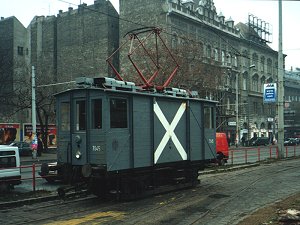 "Mukis"
are interesting beasts. As you can see on the picture to the left, they
aren't exactly modern, aerodynamic or anything like that. They have a
wooden shell built onto a steel frame as a body. Their control system
works exactly the same way as the control system of Budapest trams around
1900. What can we say? They are either obsolete - or cute :-)
"Mukis"
are interesting beasts. As you can see on the picture to the left, they
aren't exactly modern, aerodynamic or anything like that. They have a
wooden shell built onto a steel frame as a body. Their control system
works exactly the same way as the control system of Budapest trams around
1900. What can we say? They are either obsolete - or cute :-)
Mukis are service and freight locos, or cargo-trams as you would say these days. These 2-axle trams were built in 1926-27 by the company Roessemann&Kühnemann which was a company specialized for vehicles used in mining. They only produced the undercarriage, chassis and body - electrical parts were installed by BSzKRt, the Budapest tram company of that time (there were a few of them:). They were ment to be robust and easy to maintain and I guess they succeeded: these are the oldest motorcars still used in Hungary! Originally there was 40 of them, now there's only 6 left of them and a few rebuilt to snow-sweepers. A few tidbits about them: the big white X on the side was painted there because some car drivers failed to notice the locos in the fog and after a few serious accidents the tram company decided for this precautionary step. Nowadays there are two Mukis with a different paintwork: 7033 and 7038 are used as moving giant ads for a newspaper.
The Ganz cars of the Milleneum Underground
Railway
("kisföldalatti" - "small subway")
 These
cars don't have a common nickname and they aren't trams at first sight,
but indeed, these articulated vehicles were built on the basis of the
Ganz articulated trams with a few major differences.
The most striking difference is the height of the car: it's quite low.
Why? The Milleneum Undergroung Railway was built in 1896 (not a typo if
you're wondering:-) as the first electric underground line on the European
continent. It was built in just a few months to celebrate the Hungarian
Milleneum, the 1000th anniversary of the birth of our country. The tunnel
runs just below the surface of Andrássy út (Andrássy avenue) and crosses
the Grand Boulevard under which a main drain canal hides. The designers
could have either go under the pipe or "jump" over it. They chosed the
latter, but this had an important impact: they now had limited height
for the tunnel and so for the cars too. They coped with this: Siemens&Halske
(THE tram company at that time) produced the necessary low-floor vehicles.
These were by the way very modern: they were amongst the first electric
tramcars with bogies. These Siemens&Halske cars were in use until
1973, but by 1970 they were really old, so a replacement was badly needed.
These
cars don't have a common nickname and they aren't trams at first sight,
but indeed, these articulated vehicles were built on the basis of the
Ganz articulated trams with a few major differences.
The most striking difference is the height of the car: it's quite low.
Why? The Milleneum Undergroung Railway was built in 1896 (not a typo if
you're wondering:-) as the first electric underground line on the European
continent. It was built in just a few months to celebrate the Hungarian
Milleneum, the 1000th anniversary of the birth of our country. The tunnel
runs just below the surface of Andrássy út (Andrássy avenue) and crosses
the Grand Boulevard under which a main drain canal hides. The designers
could have either go under the pipe or "jump" over it. They chosed the
latter, but this had an important impact: they now had limited height
for the tunnel and so for the cars too. They coped with this: Siemens&Halske
(THE tram company at that time) produced the necessary low-floor vehicles.
These were by the way very modern: they were amongst the first electric
tramcars with bogies. These Siemens&Halske cars were in use until
1973, but by 1970 they were really old, so a replacement was badly needed.
This is the point where Ganz (Ganz-MÁVAG) jumped in: they designed a new vehicle with many components from their articulated tram. The result was a low-floor (470 mm) articulated tram that was fully compatible with the streetcars on the surface so it could be used on normal tram routes too. Unfortunately they didn't use them in this manner (only a small batch was ordered for the "small subway"), only during the test runs (in Zugló; they also carried passengers!). I remember seeing them for the first time around 1979-80: I was familiar with the normal underground ("metro") lines by then, but the "MILLFAV ("Milleniumi Földalatti Vasút") was more exciting with the nice 19th century stops and the narrow tunnels! The railway also smelled nice: I now know that this was because of the oil getting on the tracks but back then this seemed so typical that I named this the "small subway smell"...
Some of the pictures shown here were provided by Mr. Zoltán Ádám Németh, who has a brilliant collection of old public transport photos!